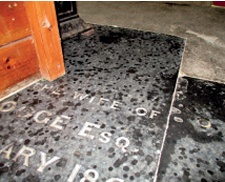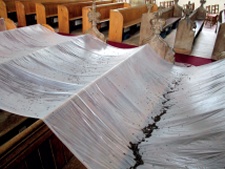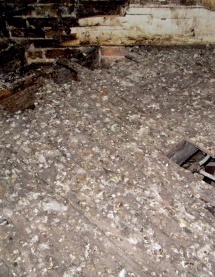Bird and Bat Guano
And its Effect on Conservation and Maintenance
Tim Hutton, David Watt and Jenny Brown
 |
|
| A gull perches atop Alfred Drury’s 1901 statue of the theologian Richard Hooker at Exeter Cathedral (Photo: Jonathan Taylor) |
Guano can be defined as the accumulated droppings of fish-eating birds and originally referred to the large deposits of this material found in coastal South America (the term’s origin is the Andean Quechuan word for dung, huano). Because of its high nitrate content it was commercially mined in the past for use in fertilisers and the manufacture of explosives.
The term has also come to be used to describe accumulations of bird or bat faeces in the built environment. As well as marring a building’s appearance, guano can cause health problems, physical damage, restriction of access and chemical and biological damage or decay, both on the exterior of buildings and internally.
The extent of additional water penetration into the guano is very important, as this may mobilise the chemicals in the material resulting in accelerated corrosion or decay. Dry material may represent an increased health hazard due to inhalation of fungal spores or other potential allergens and pathogens in airborne dust.
It must be noted that measures taken to remove guano from buildings may be more harmful to the building than the deposits themselves. As in all cases of building pathology it is necessary to take a holistic view of the affected structures and environments in order to properly diagnose the associated problems and to devise cost-effective remedial and risk management measures. This is especially true in the potentially difficult legal and public relations environment of bird and bat control.
SOURCES
Probably the main source of guano in the built environment in the UK is feral pigeons (Columba livia var). They use buildings for roosting, nesting and for ‘loafing’ while feeding. Their activities result in blockage of roof drainage systems – one of the most significant causes of damp and decay in historic buildings, costing millions of pounds each year and destroying historic fabric.
Other bird species roosting in buildings include starlings and gulls, and many others may use vantage points on buildings and other townscape features as a perching point, particularly in areas where food might be available.
Many species of bat also occupy buildings for roosting, breeding and hibernation. In the UK, accumulations of bat guano tend to be relatively small compared to those left by birds, but they can adhere to vertical surfaces, such as around openings where bats exit a building. Bat droppings can be distinguished from small rodent droppings as they are composed predominantly of digested insects and can be easily crumbled. However, large accumulations of droppings pose a particular issue and may require surfaces to be protected.
VULNERABLE STRUCTURES
Any structure suitable for occupancy by birds or bats may be subject to the accumulation of guano. Even small structures or small localised parts of structures may be affected. For example, parts of monuments or statuary used for perching by pigeons or seagulls can be heavily contaminated, resulting in severe localised aesthetic, physical and chemical effects. However, the most vulnerable structures are generally those which are poorly accessible or relatively undisturbed, especially in unoccupied or partially occupied buildings.
In all cases, the availability of food sources is likely to be a significant factor. Although both birds and bats may travel surprisingly long distances in order to feed from a particularly favourable roosting and nesting site, it is believed that the suitability of the structure for roosting or nesting and the lack of disturbance by human occupants is the most important factor.
EFFECTS OF CONTAMINATION
Physical
It is possible for the sheer weight of the accumulations of guano to cause damage to structures, particularly to relatively lightweight structures such as ceiling plaster. However, this generally occurs in conjunction with decay or partial decay.
Physical damage may be compounded because inspection and maintenance activities have been curtailed due to the presence of birds or, in particular, bats. This can be a significant problem both on the interiors and exteriors of buildings. In these cases legal restrictions or ‘fear of legal restrictions’ affecting access often hinder maintenance and conservation activities. Significant physical damage may also result from attempts to remove accumulations of guano, or to deter or exclude bird access. For example, unnecessary abrasive cleaning or the damaging installation of fixings for exclusion nets or deterrent spikes.
 |
|
| Bat urine damage to a church ledger stone | |
 |
|
| Bat guano accumulating on protective sheeting after just a short period of time (Both photos: David Watt) |
Probably the main cause of physical damage to buildings which results from the accumulation of guano, nesting materials and/ or carcasses is the blockage of roof drainage systems and other services. Blocked roof drainage systems lead to water penetrating structures and providing conditions for chemical and biological decay.
Chemical
The constituents of bird guano and urine can have direct and indirect chemical effects on building materials. However, these chemicals generally need to be dissolved in water for their direct effects to be significant, and often the most important problem arises from their ability to promote the growth of algae, bacteria and fungi.
Guano contains high levels of uric and other acids resulting in a pH of 3-4.5. These acids can attack calcium carbonate and other ‘binders’ in natural stone, artificial stone and even concrete. They can corrode metal building materials such as copper or bronze and attack their protective patina. This can result in aesthetic, and ultimately structural, problems.
Although brick and other clay-based materials may be relatively resistant to acids, they are vulnerable to damage from salts. Guano contains high levels of phosphates, ammonium, potassium, chlorides and other materials. These and the salts resulting from acid corrosion can result in severe problems of efflorescence and spalling. Similarly, the effect of the acids and salts on the porosity of masonry and other materials can result in accelerated moisture and frost damage.
Bat urine is also acidic and can cause irreversible damage to materials. In historic churches, for example, bat urine can cause staining on brass, marble, slate and polished timber, and may damage porous surfaces such as stone and terracotta.
A further potential cause of severe chemical damage to building materials is the use of inappropriate and unnecessarily aggressive cleaning materials in an attempt to remove guano. In the past there has been a particular problem with the inappropriate cleaning of decorative masonry façades, ornamental enrichments and monuments. In these cases, the solution can be worse than the original problem.
Biological
Algal and/or fungal growth resulting from the additional nitrate and phosphorous components found in guano can cause severe problems for the conservation and maintenance of historic building materials.
In particular, the high nitrate content of guano will promote the rapid growth of dry rot (Serpula lacrymans) in softwood timber structures, especially where associated with damp masonry or plaster. Although dry rot can grow in the absence of these materials, the growth of the organism is often constrained by the lack of nitrogen as well as the lack of available moisture.
Similarly, the presence of nitrogen can promote infestation and decay by wood-boring insects such as woodworm (Anobium punctatum). The increased growth of bacteria, algae, fungi and lichen also causes the production of acids and salts resulting in chemical and physical damage as described above.
Aesthetic
There is an obvious ‘yuck’ factor associated with accumulations of guano, which can cause unpleasant odours, especially if damp. The colour and appearance of soiling – and any resulting algal growth – may adversely affect the appearance of both historic exteriors and interiors. Soiling may appear as light streaking on a dark background, dark staining on a light background, or green algal staining.
HEALTH HAZARDS
As well as representing a potential slip hazard, accumulations of guano may contain potentially serious human pathogens such as campylobacter, salmonella, listeria, chlamydia (causing psittacosis), histoplasma, cryptococcus, influenza and other viruses. In addition, the living organism, carcasses, associated parasites such as fleas and mites, and nesting materials are also potential health hazards.
In the UK and Northern Europe, guano and related detritus are unlikely to cause serious clinical disease in humans, unless the deposits are grossly mishandled and people are massively exposed to them, either by ingestion or inhalation.
Nevertheless, investigations of the immune response of populations indicate that many people who are exposed to these pathogens have developed sub-clinical infections which resulted in an immune response. This might be expected, as many of these infections are described as often causing ‘mild flu-like symptoms’, and only occasionally cause more severe disease.
It is therefore probable that these infections are under-diagnosed in the UK and abroad. They can therefore cause serious and potentially fatal infections in people with HIV or under immuno-suppressed treatments. Similarly, guano and associated materials can cause severe allergic diseases such as alviolitis, so they should always be regarded as a significant potential health hazard.
MANAGEMENT AND REMOVAL
The build-up of guano in the built environment is due to a failure to prevent occupancy by birds or animals, and/or a failure to prevent the accumulation of guano. The reasons for these failures are varied but once the decision has been taken to address the problem, the role of the building pathologist and other building professionals is to prioritise the sustainable occupancy and conservation of the affected building or structure, while carefully considering any other factors relevant to the site. The key factors for consideration in this process are outlined below.
Control of pigeon/bat occupancy
Control may be straightforward in terms of the practical measures needed but it can be very difficult in terms of execution because of the complex social, cultural and legal factors which must be taken into account. As a result, large sums can be spent on pigeon deterrent and exclusion measures which are ineffective and/or harmful to the building. Often the most cost-effective way of controlling pigeon occupancy is to eliminate those birds which have been bred on the building and therefore have a ‘homing instinct’ to the structure. This is best undertaken by a programme of live trapping and culling. However, it may require careful management of interested parties and public relations to allow this to proceed. In some cases it may be illegal to disturb birds that are occupying buildings, for example when they are nesting. However, it is still possible to discourage or manage their occupancy of the building in the first place in a legal and sympathetic way.
Similarly, disturbing bat occupancy in buildings is against the law in the UK under the Wildlife and Countryside Act 1981. This can be rigorously enforced by interested parties and the local authorities, and could lead to a situation where a building becomes unusable due to the short-sighted enforcement of regulations to protect occupancy by bats in the short term. Long-term occupancy of a building by bats is often better managed by making special provision for occupancy using ‘environmental enhancements’ with the agreement of the relevant authorities. This approach may also be used cost effectively in controlling occupancy by birds, for example by providing or refurbishing existing pigeon lofts or providing owl roosts and other enhancements as part of refurbishment and conservation works.
Preventing or managing the build-up of guano
This can be achieved by modifying the built environment occupied by birds or bats to include specially designed roosting areas. Safe, routine inspection and maintenance, including the routine removal of guano, should also be considered. This should be arranged either to assist in discouraging occupancy where possible, or conversely to prevent disturbance of occupancy where this would be illegal, as could be the case with bats or nesting birds. Suitable specialist cleaning equipment may be needed, such as high-powered vacuum cleaners with medical grade filters. Current health and safety and legal requirements should be considered.
 |
|
| Pigeon guano accumulation in an abandoned building which aided the growth and spread of timber decay in the floor structure (Photo: Jenny Brown) |
While it may be possible to encourage bats to roost in a different part of a building, and thus reduce the effects of urine and droppings on a particular feature such as a church organ, it is more likely that surfaces will need to be protected. The use of sheeting over fixtures and fittings offers a solution but is unpopular with congregations and visitors as it is obtrusive and requires regular cleaning or replacement. Smaller, bespoke covers can be used over certain items, such as altars and lecterns, and these can be designed to coordinate with other fabrics in the building.
Fixtures and fittings that cannot be covered, can be protected with surface coatings or finishes such as microcrystalline waxes. These treatments need to be carefully selected and applied to avoid changing the appearance of the particular surface and are perhaps best specified by a conservator.
Floor surfaces pose a particular problem, as sheeting can reduce moisture evaporation from permeable materials and pose a potential trip hazard. Again, it may be possible to use surface treatments on certain materials as a means of offering protection from urine, but these will need to be periodically removed and re-applied.
Removal of guano
The removal of guano and contaminated materials from buildings in the UK is estimated to cost over £15 million a year. However, this figure is unlikely to include the costs of ancillary works or remedial works to deal with the consequences of contamination.
The removal and disposal of guano in buildings is often undertaken by specialist contractors or sub-contractors with appropriate practical experience and the necessary health and safety protocols. However, in the UK there is no legal requirement to employ specially trained or licensed contractors, unless the deposits contain other hazardous materials such as asbestos. Using general contractors for this work is often cost-effective, as the materials can usually be disposed of as ‘general waste’.
However, special consideration should be given to decontamination of especially vulnerable materials and structures, as unsympathetic removal can cause more damage than the guano itself. This can be a particular problem if there are decayed substrates, or where materials and finishes are decorated. Specialist conservators may then need to be brought in, at least for the critical cleaning and treatment of vulnerable surfaces.
LEGAL, SOCIAL AND CULTURAL CONSIDERATIONS
In addition to the Health and Safety at Work Act, the legislation affecting the removal of bird and bat guano from the built environment is the Wildlife and Countryside Act 1981 (Chapter 69) and potentially the Animal Welfare Act 2006. However, there can be confusion in the UK about what the current legislation allows. This may be because some have interpreted the legislation to support their own agendas; either to prevent disturbance of a particular species at all costs, or to promote the sale of, for example, pigeon-exclusion products.
As there have been few if any legal prosecutions or judgements to clarify the situation, it is possible to argue that the legislation precludes any activity that might disturb any species of bird or bat in the built environment. However, closer reading shows this interpretation is incorrect. Indeed, ‘General Licences’ for pigeon control measures and the disturbance and disposal of nests can be granted by the Department for Environment, Food & Rural Affairs or other appropriate statutory nature conservation organisations (SNCOs). These can simply be obtained online from the www.gov.uk website.
The law should not prevent a property owner or manager from removing accumulations of guano and preventing future accumulation, provided things are done at the right time and with the correct authorisations. For bats in the UK, this is controlled by SNCOs under the terms of the Animal Welfare Act 2006. These organisations are: Natural England, which is generally supported by the Bat Conservation Trust working for the local authority planning departments; Scottish Natural Heritage, which provides free advice and free site visits for domestic properties, advising on such things as mitigation; Natural Resources Wales; and the Northern Ireland Environment Agency.
However, in the UK and other parts of the world birds and bats may have special emotional significance to some groups. It is therefore always important to be sensitive to this, and it is generally wise to seek specialist independent advice.
~~~
Further Information
E Bernardi et al, ‘The effect of uric acid on outdoor copper and bronze’, Science of the Total Environment, Elsevier, London, 2009
X Bonnefoy et al, Public Health Significance of Urban Pests, World Health Organization, Copenhagen, 2008
J Hales, 'Bats in Churches: Objective assessment of associated damage mechanisms', Archaeology International 17, UCL, London, 2014 (http://doi.org/10.5334/ ai.1703)
Health and Safety Executive, 'Construction Micro-organisms: Psittacosis and other diseases from work involving bird droppings' (http://bc-url.com/ microorganisms)
T Hutton and J Dobson, ‘The control of feral pigeons: an independent approach’, Structural Survey, Emerald, Bingley, 1993
Scottish Natural Heritage, ‘Protected Mammals – Bats’
(See also www.handr.co.uk for further information and technical leaflets and articles)



